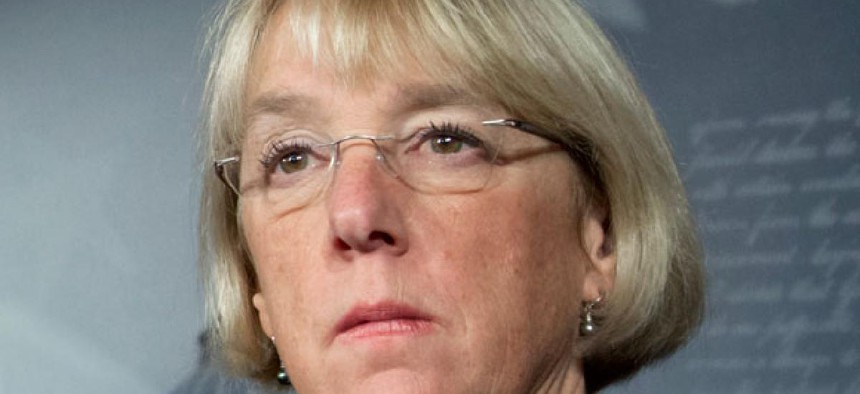
Sen. Patty Murray, D-Wash. J. Scott Applewhite/AP
Senate Democrats’ Budget Balances Spending Cuts, Revenue Hikes
Proposal shields federal pay and retirement benefits.
Senate Democrats released a fiscal 2014 budget on Wednesday that matches spending cuts with revenue hikes of equal value and protects federal workers' pay levels and retirement benefits.
The plan released by Senate Budget Committee Chairman Patty Murray, D-Wash., following hours of markup set to continue on Thursday, would replace the current sequester and achieve $4 trillion in deficit reduction over 10 years. It differs sharply from a proposal House Budget Committee Chairman Paul Ryan, R-Wis., offered on Tuesday, in that it would raise some $975 billion in revenues for deficit reduction as well as make “investments” in infrastructure and research and development.”
The revenues would come through curbing tax expenditures that critics see as loopholes. “There’s no question that we do need to look at government programs carefully, so that we can make fair, responsible cuts that put families and our economy first,” Murray said in a statement. “But a big source of spending, and one that deserves to be just as closely examined, is expenditures in our tax code. While we don’t often think of tax expenditures as a form of spending, they require us to make the same kinds of tradeoffs that other forms of government spending would, and lots of them.”
The plan suggests $975 billion in nonspecific spending cuts across the federal budget and contains language on treatment of federal workers and contractors intended to counter Republican rhetoric and proposals to reduce the overall federal workforce, as well as federal pay levels and benefits.
“Federal workers play a key role in running a smart and efficient government,” Murray’s budget said. “These workers have borne the brunt of recent deficit reduction efforts, with years of pay freezes and many workers facing furloughs in the coming months caused by the indiscriminate and untargeted sequestration cuts.”
The document noted that the Republican budget would “further harm these workers by significantly increasing their contributions to the Federal Employee Retirement System, effectively cutting their take-home pay in every paycheck.”
The plan cites potential reform ideas from President Obama’s past budgets and the bipartisan deficit reduction commissions that met in 2010 that will “save the taxpayers money, provider greater compensation parity between federal personnel and government contractors while encouraging retention of an experienced, high-quality federal workforce.”
The Democrats’ “smarter approach” to savings, the plan says, is through “reforms that will explore opportunities to better leverage the federal government’s buying power and to review contractor compensation.”
The bulk of the plan’s spending cuts would come from continuing the spending caps in the 2011 Budget Control Act for a total savings of $142 billion over 10 years. “House Republican proposals have assumed that overall discretionary funding would fall to post-sequestration levels, but have directed that all of the cuts be applied to nondefense discretionary funding—more than doubling the cuts that sequestration would require,” the plan said. It then offers examples of cuts that would help meet the spending targets.
Agriculture programs would be cut by $23 billion through reforms. Ongoing efforts to save money through reducing fraud and improper payments across government would be strengthened and applied to deficit reduction. And overlapping or duplicative programs as identified by the Government Accountability Office and the president’s budget would be given new attention by authorizing committees, a provision similar to the House GOP plan.
NEXT STORY: No Furloughs Planned at OPM







